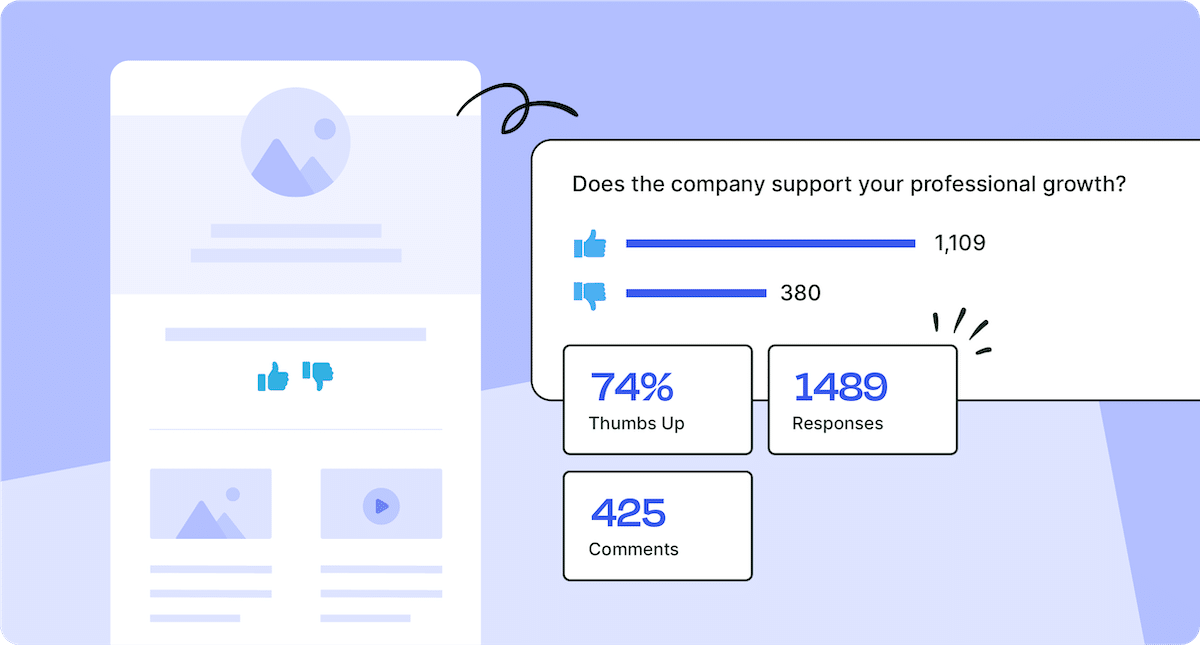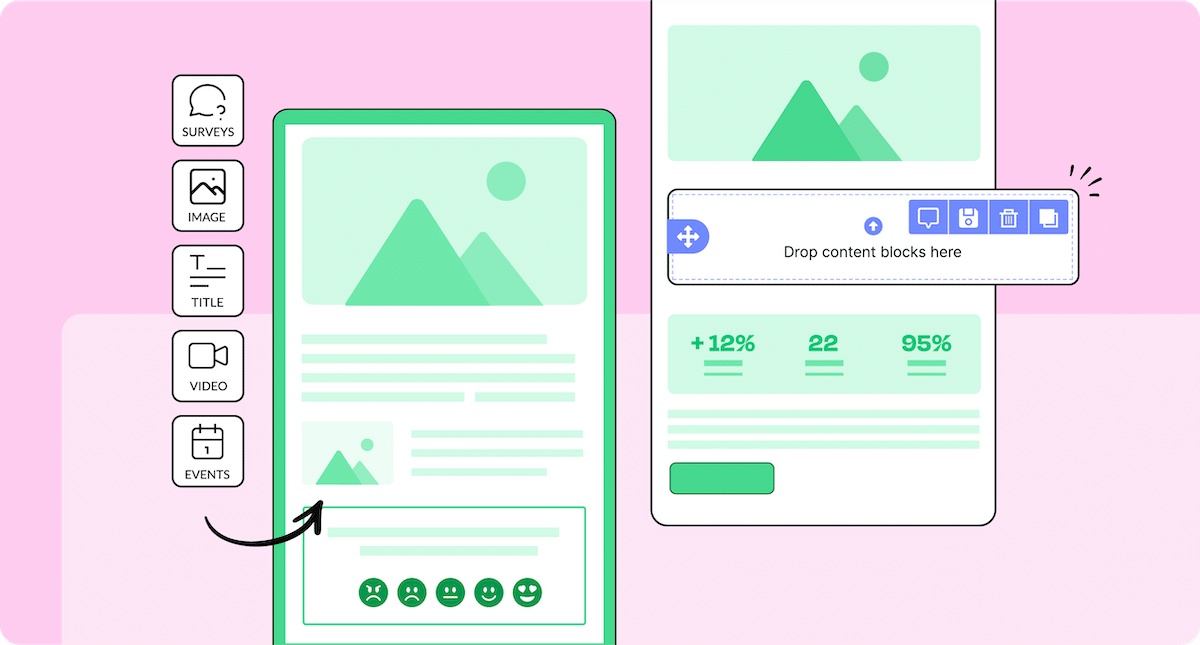Are you struggling to get employees to engage with your internal communications? If your current communication tools aren’t increasing employee engagement it may be time for a change. To set you up for success, here are the 7 best communication tools we recommend to our comms BFFs.
From team communication tools that make async collaboration seamless to internal communication platforms that put your people first, there’s no shortage of solutions out there.
But how do you know which ones are worth your time—and your budget?
Read along as we discuss the importance of communication software and select the best communication tools for your consideration.
Revive employee engagement with targeted, interactive emails and newsletters
Book a 15 minute call with one of our team members
Why Are Communication Tools and Software So Important?
Clear, consistent, and engaging communication is at the core of every successful business. But as organizations grow and teams become more dispersed, keeping everyone in sync is harder than ever.
Here’s why the best team communication software is non-negotiable in the modern workplace:
- Boosts productivity: There are no more missed messages or duplicated work. Good business communication software streamlines conversations and keeps projects on track.
- Drives engagement: Whether you’re sharing big wins or delivering leadership updates, the right internal communication tools help messages land.
- Strengthens culture: Great communication builds trust. And trust is the foundation of high-performing teams.
- Improves transparency: With clear channels, everyone knows what’s happening and what’s expected.
Communication tools and platforms are key to the overall employee experience and help you improve internal communication.
What Are the Most Popular Types of Communication Tools?
Before we share the best communication platforms, let’s look at the main types of communication tools every organization should consider:
- Messaging platforms: Think Slack or Microsoft Teams—these are great for real-time chats, quick updates, and water cooler conversations (GIFs included).
- Video conferencing tools: Zoom, Google Meet, and others bring face-to-face interaction to remote or hybrid setups.
- Project management & collaboration software: Trello, Asana, and similar tools help organize workflows, assign tasks, and keep teams moving forward.
- Internal communication platforms: Tools like ContactMonkey deliver high-impact comms directly to employee inboxes or intranets, making sure no one misses key messages.
BONUS: Check out this article to learn how to build an internal communication system that works for your organization (and IC goals).
The 10 Best Communication Tools for Business and the Workplace
When every communication tool claims to “boost collaboration” and “streamline workflows,” it’s hard to confidently commit to your tech suite. Fortunately, we’ve done the homework to find the best team communication software and which technologies increase employee engagement.
1. ContactMonkey – Best internal communication software for emails
ContactMonkey is one of the most powerful internal communication tools you can add to your tech stack. Unlike generic communication platforms, ContactMonkey is purpose-built for high-performance internal communications inside Microsoft Outlook and Gmail. The robust integration allows you to create, send, and track beautifully branded HTML employee newsletters—all without leaving your inbox.
Why it’s great: ContactMonkey stands out among employee engagement software by focusing on employee engagement and data-driven messaging. Unlike traditional business communication software, ContactMnkey empowers communicators to measure impact, personalize content, and increase visibility into employee engagement.
Pros:
- Send responsive HTML emails directly from Outlook or Gmail—no IT needed.
- Access analytics like email open rates, click-throughs, read time, and more.
- Embed employee feedback tools like emoji reactions and pulse surveys.
- Personalize messages using merge tags for employee name, location, or department.
- Integrates with HRIS platforms for smart audience segmentation.
Cons:
- Best suited for organizations using Microsoft 365 or Gmail.
- More focused on email and SMS versus chat.
Use cases:
- Sending company-wide announcements or leadership updates.
- Running employee engagement surveys or pulse checks.
- Sharing HR policies, benefits info, or onboarding materials.
Pair it with: Microsoft Outlook, Gmail, SharePoint, HRIS platforms like Workday or BambooHR.
PRO TIP: Use ContactMonkey’s list management and dynamic content features to tailor internal messages. The analytics dashboard lets you refine your internal communication software strategy and increase employee engagement over time.
Craft a winning internal comms budget proposal
Take the guesswork out of budgeting. Use our free template!
2. Slack – Best for real-time team communication software
Slack has become a household name in the world of team communication tools, and for good reason. It brings all your messages, files, and updates into one searchable communication platform, reducing email clutter and accelerating collaboration.
Why it’s great: Slack offers one of the most efficient internal collaboration tools experiences available. With channels for projects, departments, or even social topics, it’s one of the top communication tools for fast, flexible collaboration.
Pros:
- Organized channels for different teams or projects.
- Easy file sharing, integrations, and searchable history.
- Real-time messaging supports remote and hybrid workflows.
- Integrates with 2,000+ apps for workflow automation.
- Works well alongside other business communication software.
Cons:
- Message overload can cause distractions.
- Key updates can get buried in busy channels.
- Not a replacement for structured internal communication platforms.
- Limited analytics on message engagement.
- Requires thoughtful channel management and etiquette.
Use cases:
- Cross-functional team updates and discussions.
- Sharing quick project feedback or creative approvals.
- Enhancing visibility on internal initiatives through dedicated channels.
Pair it with: Asana, Trello, and Google Drive.
3. Zoom – Best video-based communication software
Zoom has cemented its place as one of the most essential communication tools in the digital workplace. It’s ideal for video meetings, virtual training, and hybrid collaboration, making it a versatile part of your business communication software toolkit.
Why it’s great: Zoom allows for seamless video, audio, and screen sharing—all key features for maintaining strong team communication tools in remote or hybrid environments. It also integrates with many internal communication platforms to round out your strategy.
Pros:
- High-quality video conferencing for large or small teams.
- Useful features like breakout rooms and live transcription.
- Supports large webinars and leadership town halls.
- Easy integration with calendars and collaboration tools.
- Works well in tandem with other communication software.
Cons:
- Not ideal for async communication or structured updates.
- Can contribute to screen fatigue if overused.
- Requires good internet connection and hardware.
- Analytics are limited compared to email-based communication tools.
- Not purpose-built as an internal communication tool.
Use cases:
- Company-wide town halls and executive updates.
- Remote onboarding and training sessions.
- Cross-department brainstorming and project check-ins.
Pair it with: Slack, Google Calendar, Outlook, and Asana.
PRO TIP: Record key meetings and embed them in your email newsletters using internal communication software like ContactMonkey to ensure async accessibility. Plus, use these video for internal communications examples to boost engagement across your team.
4. Microsoft Teams – Best all-in-one business communication software
For organizations already using Microsoft 365, Microsoft Teams is an all-in-one communication platform that blends chat, video, and collaboration tools. it’s a robust team communication software solution.
Why it’s great: Microsoft Teams centralizes messaging, file sharing, and video calls into one secure business communication software platform. Its tight integration with the Microsoft ecosystem makes it a reliable choice for scaling internal collaboration.
Pros:
- Deep integration with Microsoft apps (Word, Excel, SharePoint).
- Centralized workspace for messaging, meetings, and files.
- Secure and compliant for enterprise-level communication.
- Collaborative editing and document co-authoring.
- Strong option for hybrid and remote team communication.
Cons:
- Can feel cluttered or overwhelming for new users.
- Notification overload without proper settings.
- Not ideal for crafting long-form internal messages.
- Lacks detailed analytics for message performance.
- Dependent on Microsoft 365 subscriptions.
Use cases:
- Hosting recurring department or leadership syncs.
- Collaborating on project documents in real-time.
- Running HR Q&A sessions or onboarding touchpoints.
Pair it with: Outlook, SharePoint, Planner, and Yammer.
BONUS: If you ever need to deepen connectivity across your project-based teams, learn more about the Microsoft Teams email integration for Outlook and Gmail. And, you can also learn to send employee newsletters to Teams and make sure staff members are receiving comms via their preferred channel.
Engaging employee emails from your own inbox and servers
Send emails to 10k+ recipients and track performance in one place.
5. Asana – Best communication tool for project management
Asana is a visual and intuitive team communication software designed to streamline workflows, assign responsibilities, and keep projects moving forward.
Why it’s great: Asana helps teams cut through confusion by tracking every piece of work in a central hub. As part of your communication software stack, it excels at clarifying who’s doing what and by when.
Pros:
- Clean UI with multiple project views (timeline, calendar, list).
- Task comments keep discussions focused and on-topic.
- Workflow automation and rule-based triggers.
- Dashboard reporting for tracking milestones.
- Integrates with most team communication tools.
Cons:
- Can be overkill for very small teams or simple tasks.
- Doesn’t replace traditional internal communication platforms.
- Lacks real-time chat or video conferencing.
- Analytics more focused on productivity than engagement.
- Steep learning curve for new users.
Use cases:
- Coordinating internal comms campaigns and editorial calendars.
- Aligning HR and IT teams on onboarding workflows.
- Managing multi-department projects like DEI rollouts or for employee benefits communication.
Pair it with: Slack, Google Drive, and Zoom.
PRO TIP: Tag stakeholders in comments and assign subtasks to ensure accountability and visibility—a key part of successful team communication tools.
6. Trello – Best asynchronous communication tool for workflows
Trello is one of the most visually engaging communication tools available. Based on a Kanban board format, it’s great for mapping out internal projects, calendars, or campaigns.
Why it’s great: Trello turns complex ideas into visual flows. It’s a simple but effective team communication software for organizing tasks and tracking progress, especially for internal comms and HR projects.
Pros:
- Drag-and-drop interface makes it beginner-friendly.
- Customizable cards and checklists for every use case.
- Multiple views (calendar, table, dashboard) via Power-Ups.
- Lightweight, fast, and intuitive for teams.
- Great for planning and async updates.
Cons:
- Limited collaboration features outside of task management.
- No native video or chat support.
- Not a full-fledged business communication software.
- Analytics and reporting are limited without Power-Ups.
- Less structured than traditional internal communication platforms.
Use cases:
- Building an internal content calendar or launch roadmap.
- Planning new employee orientation processes.
- Visualizing DEI or wellness initiatives across months.
Pair it with: Slack, Google Calendar, Miro, and Jira.
PRO TIP: Use Trello’s Butler automation to trigger follow-ups or reminders—turning your team communication tools into proactive workflow drivers.
7. ProofHub – Best centralized communication platform to cut down on apps
ProofHub is a lesser-known but powerful all-in-one communication platform that combines chat, task management, file sharing, and reporting—making it a flexible internal communication tool.
Why it’s great: With ProofHub, everything from project planning to messaging lives in one space. It’s ideal for teams that want centralized business communication software without juggling multiple apps.
Pros:
- Combines chat, discussions, tasks, and time tracking.
- Simple flat pricing (not per user).
- In-app proofing and feedback features for creative teams.
- Central calendar and role-based access.
- Built-in reports and status tracking.
Cons:
- Not as robust or well-known as other tools.
- Limited real-time communication capabilities (no video).
- UI can feel outdated compared to modern communication software.
- Limited integrations with external tools.
- Less ideal for large enterprises needing deep scalability.
Use cases:
- Managing internal campaigns with messaging and feedback.
- Housing all project discussions and file versions.
- Collaborating with HR or legal on document review.
Pair it with: Google Drive, Onedrive, and Dropbox.
Secure buy-in for internal comms software
Get IT on board without the usual roadblocks.
8. Google Chat – Best for seamless communication in Google Workspace
If your organization runs on Google Workspace, Google Chat is a built-in team communication software solution that integrates messaging directly into Gmail and Google Meet. It’s a simple but powerful communication platform that helps keep conversations flowing without switching between tools.
Why it’s great: Google Chat is tightly integrated with the rest of the Google ecosystem, making it a frictionless communication tool for teams that live in Docs, Sheets, and Calendar. It’s especially effective for async collaboration and cross-functional project chats.
Pros:
- Native integration with Google Workspace apps.
- Supports one-on-one messaging and group chats.
- Allows file sharing and live collaboration from within chats.
- Threaded conversations to keep discussions organized.
- Syncs with Google Meet for quick transitions to video.
Cons:
- Lacks advanced customization options compared to Slack.
- Not ideal as a standalone internal communication platform.
- Limited built-in analytics and reporting.
- Works best within Google Workspace; less flexible with other systems.
- Basic interface may feel too simple for large teams.
Use cases:
- Quick updates between project collaborators.
- Coordinating tasks in real-time without leaving Gmail.
- Sharing links or documents across departments.
Pair it with: Google Docs, Google Meet, Google Calendar, and Google Drive.
9. Yammer (Viva Engage) – Best for social-style internal communication platforms
Yammer, now integrated into Microsoft Viva as Viva Engage, adds a social layer to your internal communication tools. It’s designed to foster connection, conversation, and culture through open, organization-wide dialogue.
Why it’s great: Yammer functions like a private social network for your company, making it one of the most people-centric internal communication platforms available. It’s ideal for building community, sharing stories, and encouraging leadership visibility.
Pros:
- Open discussion threads and communities across departments.
- Supports polls, announcements, praise, and events.
- Integrated with Microsoft Teams and SharePoint.
- Encourages cross-team connection and transparency.
- Mobile-friendly for on-the-go communication.
Cons:
- Content can get lost without good moderation.
- Not ideal for structured or formal messaging.
- Requires active participation to thrive.
- Less effective for urgent or time-sensitive updates.
- May overlap with other communication tools if not clearly positioned.
Use cases:
- Sharing employee stories and recognition.
- Creating communities of practice or interest groups,
- Leadership engagement through town halls and Q&As.
Pair it with: Microsoft Teams, SharePoint, and Outlook.
PRO TIP: Use Yammer as the cultural complement to your more structured business communication software, giving employees a place to connect and converse beyond tasks and timelines.
10. Discord – Best for voice-first team communication tools
Originally built for gamers, Discord has evolved into a popular team communication software solution for startups and creative teams. Its focus on voice, video, and informal channels makes it a unique and flexible communication platform.
Why it’s great: With always-on voice channels, custom permissions, and real-time collaboration, Discord offers a more casual, community-driven alternative to traditional business communication software.
Pros:
- Always-on voice channels for quick, hands-free communication.
- Text, video, and screen-sharing all in one platform.
- Highly customizable roles, channels, and permissions.
- Integrations with bots and third-party tools.
- Great option for remote or distributed teams who need spontaneity.
Cons:
- Informal interface may not suit all company cultures.
- Not designed specifically as an internal communication tool.
- Lacks native productivity or task management features.
- Minimal built-in analytics for tracking engagement.
- Can become cluttered without channel discipline.
Use cases:
- Hosting virtual coworking sessions or team lounges.
- Running real-time collaboration during sprints or launches.
- Quick, voice-first communication in fast-paced teams.
Pair it with: Trello, Google Docs, GitHub, and Notion.
Other Benefits of Using ContactMonkey as Your Primary Internal Comms Tool
If you’re relying on outdated or overly generic communication tools, you’re likely missing out on the deeper engagement and analytics today’s internal communicators need.
Here’s how ContactMonkey outperforms traditional business communication software and stands out among modern internal communication tools:
- Employee email made easy: Through the email template builder feature, ContactMonkey simplifies employee messaging by allowing you to design and send responsive HTML emails directly from Outlook or Gmail—no coding or IT support required for this communication software!
- Real-time analytics: Use detailed analytics like open rates, click-throughs, read time, and location-based data to gain full visibility into how employees engage with your content. The analytics dashboard feature’s insights easily help you prove ROI on your internal communication platform and overall strategy.
- Seamless integrations: ContactMonkey integrates directly with your existing tools, such as Microsoft Outlook, Gmail, SharePoint, and HRIS platforms. It also fits easily into your current communication platform stack.
- Scalable for growing teams: Whether you’re sending updates to 50 or 50,000 employees, ContactMonkey scales effortlessly thanks to the email-at-scale feature. Its enterprise-ready infrastructure makes it a reliable part of any business communication software stack.
Adopting ContactMonkey as the center of your internal communication tooling means less guesswork, more engagement, and better outcomes.
Ready to build a smarter internal comms tech stack? Book a demo to see how our modern internal communications software can drive efficiency and higher engagement without the fuss.


